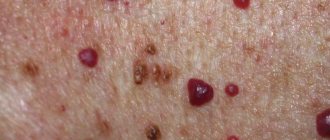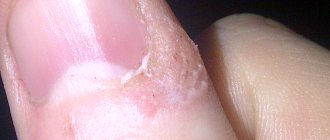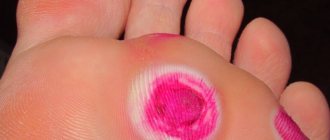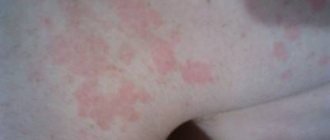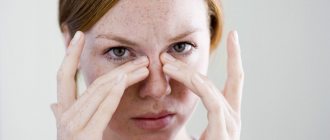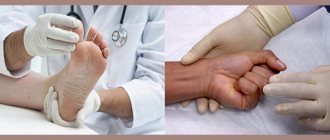If you think that the fungus only affects the feet, hands and nails, then you are deeply mistaken. This insidious disease can be found on any part of the body, including in the armpit. There is a rational explanation for this. The fact is that a humid environment is ideal for the existence and reproduction of fungi. Which area on our body is most susceptible to increased sweating? Of course, armpits. Let's look at the reasons why fungus appears under the arms and whether it is possible to get rid of it.
Symptoms of fungus under the arms
It is difficult not to notice this illness; it is too obvious even for those patients who are accustomed to not taking their health seriously. Mycotic (fungal) diseases should be treated as quickly as possible, otherwise the spores will spread over a larger area of the skin surface.
Fungus under the armpits (photo of the disease is shown below) appears quite often, since friction often develops in this area of the body. Also, the appearance of mycoses can be facilitated by the use of aggressive deodorants that dry out the skin, wearing synthetic clothing, etc. The armpits are an area of the body to which air access is almost always limited.
How to understand that the appearance of discomfort under the arms is a fungus? In fact, identifying a mycotic infection is quite simple if you know some of the differences in the symptoms of fungal diseases.
- Mycosis (fungus) should be distinguished from lichen. The first is characterized by the appearance of peeling, redness, without swelling and without pain or burning. In some cases, itching may occur and cause discomfort. As a result, the patient scratches the problem area of the skin, after which scratches may remain, which will already cause pain, and purulent discharge may appear. Therefore, if itching occurs, you should use special ointments and refrain from scratching the problem area.
- Atopic dermatitis is not a fungal disease, but many patients, when symptoms appear, confuse this disease with ringworm or a fungus of the skin under the arms. Atopic dermatitis is characterized by the appearance of small ulcers, from which pus or ichor may be released. The area of damaged skin turns red, and small scars may remain after the exacerbation of the disease has passed.
- Linear lichen quite often appears in the skin of the armpits. This disease is characterized by the appearance of pink, purple or brown spots that hurt. The patient experiences a burning sensation, and over time the affected area may grow.
Symptoms
Mycosis of the armpits is recognized by special symptoms that, some time after infection, begin to bother a person. As a rule, the signs of the disease are easily recognizable. Therefore, it is not difficult for a doctor to accurately determine the diagnosis.
Mycosis of the armpits is recognized by the following characteristic features:
- Increased sweat odor
- The appearance of cracks and erosions in the problem area,
- Coarsening of the skin under the arms,
- Itching,
- Redness of the skin.
Read also: Pathogenic fungi 300 million people get sick, and 1.6 million die from fungi per year
In 80% of cases, the disease has exactly this clinical picture. Patients also often complain about the appearance of rashes in the affected area and its peeling. The formation of a small rash, which contains purulent masses inside, cannot be ruled out.
Wanting to get rid of the unbearable itching, the patient begins to actively scratch the infected area. This action provokes the formation of cracks. They do not heal for a very long time, as a person sweats so much.
Additional signs can be used to determine whether a person is developing an infection caused by yeast-like fungi in the armpits. In this case, the patient will experience redness of the skin, as well as a white coating. It can be painlessly removed with a cotton swab. However, after a while he will appear again.
Causes of discomfort
What is the reason for the appearance of fungus under the arms? The photos show an unsightly picture; many patients think that the reasons for the appearance of fungus are insufficient compliance with hygiene rules. This is a misconception: you can take a shower several times a day, but this will not affect the severity of mycotic pathologies.
The following are the most common causes of fungus in the armpits and groin:
- Hormonal surges, as a result of which immunity decreases and the body’s defenses are depleted. Most often this occurs during puberty, and similar hormonal surges are typical for women during menopause.
- With hyperthyroidism and diabetes, fungal spores are often activated, which almost always leads to the development of itching and spots in the armpits. Almost all people with diabetes are familiar firsthand with fungal skin diseases and dermatitis of various etiologies.
- Hereditary predisposition, skin susceptibility to fungal diseases and dermatoses, high allergy.
- Obesity and simply being overweight is an additional factor in the formation of mycotic spots, since sweat and its decomposition products accumulate in the fat folds.
- Stressful situations, chronic fatigue, in which the activity of the sweat glands increases and immunity decreases at the same time - this combination leads to the activation of fungal spores.
- Chronic infectious diseases that slowly but inevitably worsen the immune system.
Causes
Certain types of fungus do not cause any problems to humans, but if there is a sharp decrease in the immune system, then its active reproduction and spread begins.
This occurs due to the fact that the material metabolism of the skin and the acid balance are disrupted, which could block the previously enhanced development of the fungus of the genus Candida.
Most often, this pathology occurs in people prone to excessive sweating (hyperhidrosis).
Scraping for skin fungus
Fungal infection is one of the most common pathologies related to skin diseases.
The following factors have been identified that most often manifest the disease:
- Active sports.
- Work in hot rooms.
- Diabetes.
- Various types of chronic diseases.
- Taking antibiotic drugs that contribute to the development of dysbiosis.
- Excess body weight.
- Regular stress.
- Transitional age and pregnancy due to disturbances at the hormonal level.
- Age after 55 years.
- Metabolic disease.
Also, the disease often manifests itself due to non-compliance with basic rules of personal hygiene; frequent shaving of the armpit area causes microtraumas that contribute to the development of fungus.
Is it possible to become infected through household items and clothing?
There is an opinion that the fungus can be infected through household items: shared bedding, dishes, shoes, clothes, towels. This opinion is only partly true: even if mycotic spores get on the skin of a healthy person, this does not necessarily guarantee the appearance of spots, itching, or peeling.
As mentioned above, spores of mycotic infections can be found on the skin of almost any person. But they are activated only if the body and immunity are so weak that they are unable to stop the process.
Possible complications
This disease is dangerous because the fungus is resistant to various factors and is characterized by rapid damage to new areas.
Since patients constantly experience itching, wounds form at the affected areas due to constant scratching, through which pathogens and infections can enter the body. Therefore, a disease such as a fungus requires mandatory and timely treatment.
Often, when scratching, purulent formations appear, which subsequently open. Without therapy, recovery is delayed and will require more time and effort. If the patient receives the necessary help, the abscess heals quickly.
Which doctor should I contact?
If a patient suspects lichen or fungal diseases, or if red itchy spots appear in the groin area or armpits, be sure to make an appointment with a dermatologist for diagnosis. It is important to determine what the cause of the disease is - lichen, candida or a fungus of another origin.
Dermatologists are admitted free of charge; if you have a medical policy, all costs will be borne by the Insurance Company. If the patient wants to undergo an examination anonymously, he can contact a paid diagnostic center.
Modern diagnostic methods
As a rule, to determine the type of fungus, it is enough to take a scraping from the affected area. Experienced doctors sometimes only need to conduct a visual examination and listen to the patient’s complaints in order to accurately determine the cause of the pathology.
The sooner treatment begins, the greater the chance that it will be successful and the fungus will not spread to large areas of the skin. In some cases, if chronic diseases of internal organs are suspected, a dermatologist may also refer the patient to undergo a general or biochemical blood test. This is required in order to identify the underlying disease (perhaps the patient has diabetes, problems with hormones, liver or pancreas diseases) - and treat it, which will have a positive effect on the condition of the skin.
Review of treatment methods for armpit fungus
There are several main areas of therapy. How to get rid of armpit fungus for a long time, while avoiding relapses of the disease? It is optimal to use the following treatment methods in combination:
- external (ointments, creams, balms);
- internal (taking pills and antifungal drugs);
- vitamin and mineral therapy.
If you use only one method (for example, ointment), the fungus under the armpit may take a long time to resolve, and then the patient will suffer from a relapse of the disease. Therefore, it is optimal to use several methods of therapy at once - for example, combining the use of ointments with taking tablets. This treatment will achieve maximum effect and relieve the patient from the disease.
Treatment
Therapeutic measures should be prescribed by a specialist dermatologist, since here it is necessary to remember that the axillary zone is a favorable environment for the development of pathology, and also that pathology spreads quickly and is difficult to eliminate.
Self-medication is dangerous with complications!
Attention
Despite the fact that our articles are based on trusted sources and have been tested by practicing doctors, the same symptoms can be signs of different diseases, and the disease may not proceed according to the textbook.
Pros of seeing a doctor:
- Only a specialist will prescribe suitable medications.
- Recovery will be easier and faster.
- The doctor will monitor the course of the disease and help avoid complications.
find a doctor
Do not try to treat yourself - consult a specialist.
Initial therapy stops the spread of the lesion to healthy areas.
Before deciding on treatment, the dermatologist determines the extent and area of the lesion. The doctor prescribes medications that strengthen the immune system and dry out the lesions.
Medications
The therapy is prescribed in a comprehensive manner, and it is aimed not only at eliminating the symptoms, but also at the causes of their occurrence; for this, the following measures must be taken:
- If the protective barrier is weakened the immune system ; immunostimulants and vitamin complexes must be prescribed.
- When the sweat glands work hard, it is necessary to take medications to eliminate hyperhidrosis.
- Symptomatic therapy - for this, ointments, creams, sprays are prescribed, which have a drying effect, anti-inflammatory and healing effect. Blocks the development of fungus.
- Prevention measures - if the body is prone to developing a fungal disease, it is recommended to carry out hardening measures, strengthening the immune system, switching to a healthy diet, and normalizing the functioning of the sweat glands.
Application of ointments
Without the use of local treatment, getting rid of fungal infection is impossible. For this purpose, various ointments, creams and sprays with a drying effect are used. Prescription of medications occurs individually, based on the degree of pathology, anatomical features of the skin and other factors. But in any case, it is necessary to prescribe antifungal agents that eliminate fungal diseases.
Creams and ointments with antimycotic action
How to cure armpit fungus if the disease brings constant discomfort and itching? You cannot do without using ointments for external use; here is a list of the most effective:
- "Clotrimazole" is available in the form of gel, cream and ointment (each product has a different concentration of the active substance). The main component is an antimycotic substance called clotrimazole. The product should be applied in a thin layer to the affected area twice a day. Reviews about the ointment are the most positive: patients note an improvement in their condition after just a few days of use.
- Lamisil is available in the form of a spray and ointment. The main active ingredient is terbinafine. There is a cheaper analogue, which is called “Terbinafine”, but, as a rule, it is not available in pharmacies.
- "Fugnoterbin" is an effective ointment that is active against almost any type of fungus.
- "Mikonorm" is an ointment that reduces the severity of itching after the first use. The main active ingredient is also terbinafine hydrochloride.
- Terbizil is another popular ointment that is effective against almost any type of fungal pathology.
Tablets with antimycotic action
How to treat armpit fungus so that it doesn’t come back again? Most often, getting rid of the visible manifestations of the disease is quite simple, but preventing a relapse is more difficult. Dermatologists recommend combining both internal and external methods of therapy. To do this, you should take a course of tablets in parallel with the use of creams and ointments.
- Fluconazole is probably the cheapest and most popular remedy against the manifestations of candidiasis and many other fungal pathologies. Before starting use, you should consult a dermatologist.
- Itraconazole is a tablet drug that kills almost all types of spores. It has contraindications for use, side effects are possible, so before starting use you should consult a dermatologist.
Vitamin and mineral complexes for skin
As mentioned above, fungal skin lesions should be treated comprehensively. Taking vitamin-mineral complexes is a simple way to avoid deficiencies of vital microelements. Below is a list of complexes, the use of which will allow you to achieve the fastest possible healing of the skin and return it to its original form:
- "Perfectil" contains minerals, vitamins, as well as plant extracts, the presence of which in the composition contributes to the rapid restoration of the epidermis. While taking it, immunity will increase and hair loss will stop (due to the zinc content in the composition).
- “Brewer's Yeast Esvitsin” contains faith and a full complex of B vitamins, due to which it can quickly restore the skin.
- "Pantovigar" - vitamins containing brewer's yeast, promote regeneration and improve the protective properties of the epidermis.
Traditional methods of treating fungus
Traditional methods of combating armpit fungus are still popular:
- Affected areas of the skin can be wiped with a decoction of calendula and oak bark. Infusions of these herbs have an astringent and drying effect. For a glass of boiling water, take a tablespoon of the dry mixture, leave for a couple of hours and wipe the affected areas with a cotton pad soaked in the infusion.
- A decoction based on common burdock and chamomile flowers. You will need 50 g of dried flowers, 50 g of fresh burdock and 500 ml of water. Boil for 30-40 minutes over low heat. Then let it cool, strain and lubricate the skin where the lichen appeared.
ethnoscience
To combat mycosis of the armpits, traditional methods are used.
It is important to remember that only a healthy body can overcome fungus on the skin. Cream for armpit fungus, tablets and sprays will not be able to cure it if the immune system is suppressed.
However, it should be remembered that they are not capable of completely replacing drug therapy.
- Calendula tincture diluted in water (1:1). Used daily 3 times a day.
- Water mixed in equal quantities with apple cider vinegar is applied to the fungus-affected area 2 times a day.
- Treat the skin under the arms with baking soda, diluted equally in water. The product is left for 5 minutes, then washed off. The procedure is carried out in the morning and evening.
- Lemon juice is applied to cracks and abrasions.
- Every day the skin under the arms is treated with tar soap.
Decoctions of oak bark, sage, and chamomile infusion mixed with soda (in equal quantities) are effective against fungus. Frequency of treatment – 3 times a day.
How to prevent relapse of pathology?
In order to prevent the recurrence of symptoms of fungus under the arms, you should undergo a full examination, stop chronic diseases of the internal organs, give up bad habits, and switch to proper nutrition. This set of measures will help strengthen the immune system, as a result of which fungal spores simply do not become active.
If the patient has diabetes, it is recommended to adhere to a special low-carbohydrate diet and not stop taking medications (if necessary, insulin injections). If you maintain the sugar level at an acceptable level, the fungus will not bother the patient.
Prevention
It is easier to prevent the development of a disease than to subsequently eliminate it; this will help save time and money. To do this, you must adhere to the following preventive rules:
- Always use personal hygiene items: towel, washcloth, soap.
- Do not wear someone else's clothes and shoes.
- Dry and clean shoes after each use, since they often cause the development of fungus, which spreads to the armpit area. Drying can be done using crumpled paper or using special dryers and shoe bags.
- Avoid frequent use of clothing made of synthetic fabric.
- Wash regularly and do not rewear them.
- Use antiperspirants and deodorants.
- Shoes must be worn when walking on floors and ground . Walking barefoot is considered the most dangerous when there is high humidity in public places. This also includes visits to swimming pools and baths.
It must be remembered that if the disease has manifested itself once, the risk of its reoccurrence greatly increases; it is for this reason that when prescribing treatment, it is necessary to carry out a full course of treatment, regardless of how early all the symptoms have passed.
To completely eliminate the fungus, in addition to symptomatic medications, it is necessary to take vitamins and strengthen the immune system.
It is also recommended to carry out physical exercises in the fresh air and harden the body; such activities help to increase the protective barrier and determine resistance to the penetration and activity of infection.



